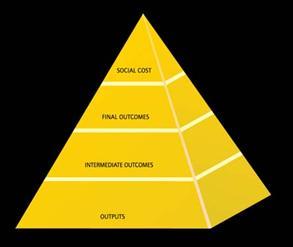Results
- Conditions of entry and exit of vehicles and road users to the road network
- Funding and resource allocation
- Institutional management functions
- Interventions
- Legislation
- Monitoring and evaluation
- Multi-sectoral co-ordination
- Planning, design, operation and use of the road network
- Promotion
- Recovery and rehabilitation of crash victims from the road network
- Research and development and knowledge transfer
- Results focus
- The evolution of road safety management for results
- The road safety management system
- The road safety management system
Results
The final element of the road safety management system concerns the measurement of the desired results and their expression as targets in terms of final outcomes, intermediate outcomes, and outputs, as shown in Box 2 [6]. Targets specify the desired safety performance endorsed by governments at all levels, stakeholders and the community. The level of safety is ultimately determined by the quality of the delivered interventions, which in turn are determined by the quality of the country's institutional management functions.
| Box 2: Safety Targets Bliss, 2004 [6] | ||
|---|---|---|
| Final outcomes | Final outcomes can be expressed as a long term vision of the future safety of the road traffic system (e.g. Vision Zero and Sustainable Safety) and as more short to medium term targets expressed in terms of social costs, fatalities and serious injuries presented in absolute terms and also in terms of rates per capita, vehicle and volume of travel. | |
| Intermediate outcomes | Intermediate outcomes are of value for their contribution to improved final outcomes and they include average traffic speeds, the proportion of drunk drivers in fatal and serious injury crashes, seatbelt-wearing rates, helmet-wearing rates, the physical condition or safety ratings of the road network, and the standard or safety ratings of the vehicle fleet. | |
| Outputs | Outputs represent physical deliverables, for instance the number of police enforcement operations required to reduce average traffic speeds, or alternatively they can correspond to milestones showing a specific task has been completed. | |
Good practice countries set quantitative outcome and intermediate outcome targets to achieve their desired results focus. They can also set related quantitative output targets in line with the targeted outcomes as in the New Zealand example.
New Zealand's target hierarchy LTSA, 2000 [40]
- The overall target is to reduce the socio-economic costs of road crashes
- To be achieved by meeting the second level of targets, requiring specific reductions in the numbers of fatalities and serious injuries
- A third level of targets consists of intermediate outcomes (including those related to speed, drink driving and rates of seat-belt wearing) that are consistent with the targeted reductions in final outcomes;
- A fourth level of targeting is concerned with institutional delivery outputs such as the enforcement outputs that are required to achieve the third-level targets
European targets
The WHO Health for All policy in Europe sets international targets for reducing road deaths and injuries, calling for reducing mortality and disability from road crashes by at least 30% by 2020.
The European Union has adopted the goal of reducing fatalities by 50% by 2010. This target represents an ambition to reduce the number of deaths more quickly than continuation of past trends would imply
The European Conference of Ministers of Transport adopted a target of reducing road deaths by 50% by 2012, to serve as a benchmark for its 43 Member States.
See Quantitative road safety targets: and Safety Ratings ERSO web text for further information.

